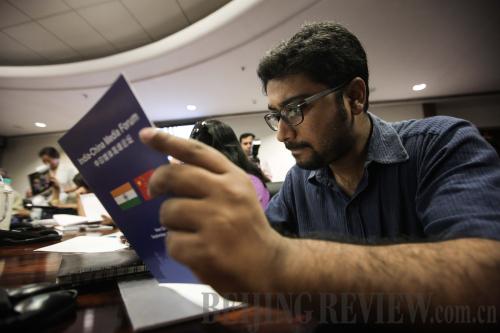|
 |
|
FOR BETTER UNDERSTANDING: An Indian press delegate reads handouts distributed at the First China-India Media Forum held in New Delhi on September 16, 2013 (ZHENG HUANSONG) |
It was a miracle that the First China-India Media Forum could be launched at all in 2013, a year heralding changes in the political leadership of both countries.
China's new leadership, led by President Xi Jinping, have subsequently set in motion sweeping changes—cracking down on corruption, reducing bureaucratic hurdles to add impetus to trade and commerce, and seeking to improve the rule of law. In India, the changes have been even more dramatic. The ruling Congress Party lost in both regional and the general elections and the nationalist Bharatiya Janata Party's Narendra Modi became the new prime minister.
With the second edition of the forum now slated to be held in Beijing on February 1, it seems that despite the change of guard, both the countries—their political dispensations, non-governmental organizations (NGOs) and media groups—still think the media has an important role in shaping bilateral ties.
Hopefully, the forum will come up with concrete measures to improve media cooperation, exchanges and balanced reporting by featuring stories that go beyond the sensational "man-bites-dog" variety.
Root of mistrust
Kaiser Kuo, International Communications Director at Baidu.com, the Chinese version of Google, said that while surfing Quora, an e-forum for bloggers and people seeking information on diverse subjects, he was struck by the barrage of queries, apparently from Indians, on China. It was in September 2014, almost four months after Modi had been sworn in and Xi had just paid a three-day official visit to India.
Kuo said he jotted down the queries by Indian users from September 22 and 25, finding that all 28 were about security. They wondered if the two nations could go to war again, who would win if that happened, and bilateral rivalry in other areas. However, there were no questions from Chinese surfers.
"Very few Chinese are aware of border issues," Kuo told Beijing Review, referring to the territorial dispute in 1962. "Not many are aware of the territories in dispute. I would be hard-pressed to name even one area of Chinese concern about India except perhaps support for Tibet Autonomous Region and the so-called "government in exile" of the Dalai Lama in [India's] Dharamshala. But that's not an insurmountable problem. It's a 50-year-old thing and not an issue now. The sad truth is that most Chinese just don't think that often about India. It's certainly not regarded as a threat."
In India, on the other hand, a lot of the China coverage is "influenced by a general fear of the country," said Rahul Sharma, President of Rediffusion Communications at Rediffusion Y&R, a marketing and advertising company, and former editor of Hindustan Times, Delhi, one of the most popular newspapers in India. "The Indian media, just like the Indian Government, tend to look at China through the small prism of the 1962 war and the events that followed. The fear of a giant 'unfriendly' neighbor is real and the media merely reflect that."
Dr. Amitendu Palit, senior research fellow at the Institute of South Asian Studies, National University of Singapore, agreed with him. "The border issue continues to remain a favorite one for the media," he told Beijing Review, adding that the Indian media have been crying hoarse over Chinese infrastructure-building in border areas and been active in reporting incursions across the border. "The Chinese efforts to build dams on upper Brahmaputra [the Yarlung Zangbo River] have also been contentious issues. Indian media are keener on reporting China's activities that affect India as a neighbor, rather than China's global and regional engagements or domestic issues. There is a heavy reliance on part of the Indian media to rely on Western reports on China."
Sharma, who has also worked for the international media, thought other media suffer from Sinophobia as well, "Everybody is paranoid of China because its growth has changed the global balance. There was one superpower, then two, and then one again. China's ambitions to become a great power are a threat to everybody and will take time for each nation to find a way around it.
He felt that Chinese foreign policy is assertive and that does not go down well with most countries. "That gets reflected in the media, which today is looking for eyeballs and mind space in a crowded marketplace," he said.
How do the Chinese media see India? Palit said the coverage is much less than what it can be. "Modi's election and his strategic engagement with the region and major powers have attracted some attention in the Chinese media [but their] typical interests in India have been on business and economic issues. These too, over the last few years, have been covered only sporadically given India's subdued economic performance."
| 